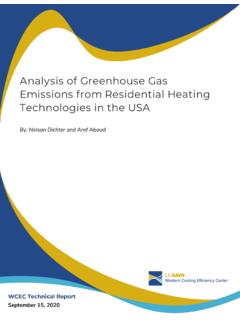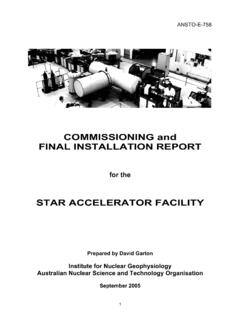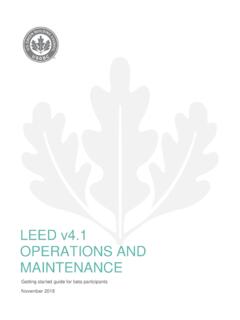Transcription of Testing, Adjusting and Balancing HVAC Systems: An Overview ...
1 Testing, Adjusting and Balancing HVAC Systems: An Overview of Certification Agencies Fredrick Meyers and Theresa Pistochini WCEC Technical Report May 12, 2020 2 Recommended Citation Meyers, Fredrick and Theresa Pistochini. Testing, Adjusting and Balancing HVAC Systems: An Overview of Certification Agencies. University of California Davis Western Cooling Efficiency Center. May 12, 2020 Acknowledgement The research team acknowledges individuals who provided information through personal interviews and written comment for this whitepaper, including Ray Bert from the Associated Air Balance Council, Tiffany Suite from the National Environmental Balancing Bureau, Christopher Ruch from the National Energy Management Institute, and John Hamilton from the Testing, Adjusting and Balancing Bureau.
2 Contacts Fredrick Meyers, UC Davis Western Cooling Efficiency Center, Theresa Pistochini, UC Davis Western Cooling Efficiency Center, WCEC Technical Report May 12, 2020 1 INTRODUCTION Testing, Adjusting , and Balancing (TAB) is a process where air and hydronic flows in a building are measured, adjusted, and documented to meet design specifications and local building codes to ensure thermal comfort, indoor air quality, and system energy efficiency are optimized. In order to improve the quality of the TAB process , tests should follow a standardized methodology and be completed by a certified technician.
3 TAB certified specialists use their knowledge and experience to verify, test, and adjust heating, ventilation, and air conditioning (HVAC) systems after installation or retrofit, during a building s commissioning process , or anytime evaluation of existing buildings is needed. In this article, we will examine the benefits of using a certified contractor for TAB and describe the three main certifying agencies and differences between them. The three main certifying agencies are: Associated Air Balance Council (AABC) National Environmental Balancing Bureau (NEBB) Testing, Adjusting and Balancing Bureau (TABB) State and local regulations for testing, Adjusting , and Balancing HVAC systems vary across the United States.
4 The building Code Assistance Project keeps track of which states have adopted the American Society of Heating, Refrigerating and Air-Conditioning Engineers (ASHRAE) Standard Energy Standard for Buildings Except Low-Rise Residential Buildings. This standard includes requirements for commissioning buildings and includes TAB requirements. Many states have adopted Standard or its equivalent (Figure 1); however, there is considerable variation in the adoption of energy standards that include TAB requirements. A few examples below illustrate this variation: Colorado does not have statewide energy standards, but does work with counties to help them adopt the International Energy Conservation Code (IECC), which has TAB requirements, on a local level.
5 New York adopted the IECC (except where otherwise approved by the local agency). California s mechanical code section requires that ventilation systems shall be balanced in accordance with the latest edition of standards published by [AABC, NEBB, or TABB]. In addition, California s Title 24 building Energy Efficiency Standards (Part 6) requires acceptance testing of covered newly installed or retrofitted mechanical systems and that acceptance testing must be completed by Acceptance Test Technician Certification Providers (ATTCPs)1. 1 Acceptance testing must be completed by an ACTTCP once the California Energy Commission determines that sufficient certified technicians are available in the state.
6 2 Regardless of the local building codes, building owners will benefit from conducting TAB when commissioning new buildings and periodically for existing buildings. TAB improves energy efficiency of HVAC system operation, and the health and well-being of occupants by ensuring required ventilation rates for indoor air quality are met. Figure 1: Energy code adoption in USA. TAB requirements are usually a section within the energy code [1]. WHY CERTIFY? The certification process evolved from a market need to ensure that installed HVAC systems operate as intended and perform to design specification.
7 A certified TAB contractor may even make design suggestions or adjustments depending on the differences between theoretical operation vs. the actual installation. The need for highly skilled technicians has increased with the complexity of HVAC systems, such as electronic controls, variable speed devices, and/or economizers. As a result, associations were established to standardize and train the industry for the benefit of building owners, architects, contractors, inspectors, and occupants. 3 Certification provides assurance to building owners that a particular contractor will meet a specified level of quality.
8 While local regulations may not specify a particular certification, private organizations may write their own requirements beyond what building codes require. In this case, building owners can specify that a Balancing procedure must follow a certain standard and/or be performed by a contractor with a specific certification. The value of TAB certification, however, goes beyond meeting specifications. During interviews conducted by the UC Davis Western Cooling Efficiency Center (WCEC), TAB agencies expressed that certification serves as a verification that their employees have the knowledge and experience needed to complete on the job tasks.
9 In addition, a technician with a certificate can use it to advance their career. In other words, passing a test and training course administered by a third-party provides mutual benefit to both employer and employee. In addition to providing a baseline level of knowledge, a certifying agency helps contractors and technicians remain up-to-date with new practices. Advanced control systems, automated instruments, and new standards are constantly changing in the market. To support contractors and technicians, all the major certifying agencies provide regular training seminars and require a certain number of Continuing Education Credits (CECs) to maintain certification.
10 CERTIFICATION TYPES While different agencies use different terminology, certification generally falls into one of three levels: technician, supervisor, or firm. The technician is responsible for actually performing the work and it is extremely important that this person be skilled in their job. The technician level certification is designed to ensure TAB is performed by a qualified individual who understands underlying processes. Additionally, the technician obtains skills for proper reporting of TAB results, understanding local codes, and how to take care of measurement equipment.









